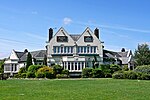Bardsey cum Rigton
City of LeedsCivil parishes in West YorkshireOpenDomesdayUse British English from January 2019West Yorkshire geography stubs

Bardsey cum Rigton is a civil parish in the City of Leeds metropolitan borough in West Yorkshire, England. According to the 2001 census it had a population of 2,385, increasing to 2,525 at the 2011 Census. The parish includes the villages of Bardsey, East Rigton and Thornhurst.
Excerpt from the Wikipedia article Bardsey cum Rigton (License: CC BY-SA 3.0, Authors, Images).Bardsey cum Rigton
Wetherby Road, Leeds Bardsey cum Rigton
Geographical coordinates (GPS) Address Nearby Places Show on map
Geographical coordinates (GPS)
| Latitude | Longitude |
|---|---|
| N 53.882 ° | E -1.44 ° |
Address
Wetherby Road
Wetherby Road
LS17 9DJ Leeds, Bardsey cum Rigton
England, United Kingdom
Open on Google Maps










